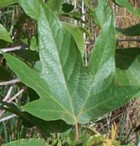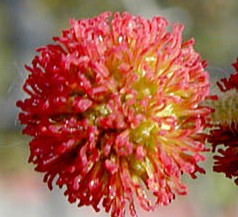 Also known as Buttonwood, this deciduous tree is native to California where is grows in moist sites. It is a member of the sycamore family (Platanaceae), a small family with only one genus and eight species. In their natural habitat they often have picturesque shapes with a gnarled double trunk and contorted wide-spreading branches. The reddish-brown bark is exfoliating to create patterns of white, gray, and green. The leaves are palmately lobed with three to five pointed lobes and are up to nine inches long and ten inches wide. They are soft light green above, and lighter green with yellow hairs below. In the fall the leaves turn brown and sometimes persist on the tree until early spring. The red male and female flowers appear in racemes on the same tree in late winter and spring and the female flowers give way in summer to clusters of dark brown, golf ball sized, aggregate fruits of achenes and remain on the tree into fall. Plants tolerate heat, smog, and some wind although the branches are brittle and may snap in high winds. The pollen and hairs on the leaves can cause nasal irritation so trees are best used away from patios and heavily used areas.
Also known as Buttonwood, this deciduous tree is native to California where is grows in moist sites. It is a member of the sycamore family (Platanaceae), a small family with only one genus and eight species. In their natural habitat they often have picturesque shapes with a gnarled double trunk and contorted wide-spreading branches. The reddish-brown bark is exfoliating to create patterns of white, gray, and green. The leaves are palmately lobed with three to five pointed lobes and are up to nine inches long and ten inches wide. They are soft light green above, and lighter green with yellow hairs below. In the fall the leaves turn brown and sometimes persist on the tree until early spring. The red male and female flowers appear in racemes on the same tree in late winter and spring and the female flowers give way in summer to clusters of dark brown, golf ball sized, aggregate fruits of achenes and remain on the tree into fall. Plants tolerate heat, smog, and some wind although the branches are brittle and may snap in high winds. The pollen and hairs on the leaves can cause nasal irritation so trees are best used away from patios and heavily used areas.

Type: Deciduous tree
Outstanding Feature: Bark, habit
Form: Sprawling, round, open canopy; often twited and gnarled
Growth Rate: Rapid
Bloom: Racemes of inconspicuous male and female flowers on the same tree in late winter and spring
Size: 40-50’ H x 50-70’ W
Light: Full sun to some shade

Soil: Prefers deep, rich,moist, well-drained; tolerates less.
Hardiness: Zones 7-10
Care: Can be pruned hard but more beautiful if allowed to grow naturally.
Pests and Diseases: Anthracnose, red spider
Propagation: Fresh seed with cold stratification